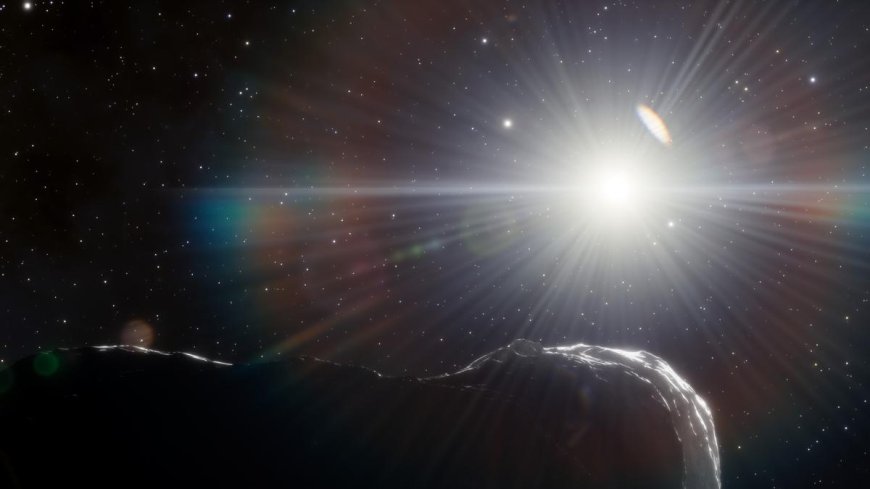Asteroid YR4 might miss the earth. Will it miss the moon, too?

Asarkari - Sarkari News, Jobs & Updates
Asteroid YR4 Might Miss the Earth. Will It Miss the Moon, Too?
By Priya Singh
The vastness of space is a source of constant wonder and, occasionally, a little bit of cosmic nervousness. Recent discussions and tracking data concerning near-Earth objects (NEOs), such as the asteroid designated YR4, often spark public interest and a flurry of questions. While current predictions suggest Asteroid YR4 is likely to give our planet a wide berth, a crucial follow-up question arises: if it misses Earth, does that automatically mean it will miss our celestial neighbour, the Moon?
Understanding the Cosmic Dance: Asteroid Trajectories
Before we delve into the specifics of YR4 and the Moon, it's helpful to understand how scientists predict the paths of these celestial travellers. Asteroids, remnants from the early solar system, predominantly orbit the Sun. However, their paths are not simple, straight lines. The gravitational pull of planets, especially giants like Jupiter, and even smaller bodies like Earth and the Moon, can significantly alter an asteroid's trajectory over time.
Space agencies like NASA and ESA, along with observatories worldwide, dedicate enormous effort to detecting, tracking, and cataloguing NEOs. By observing an asteroid over time, astronomers can calculate its orbit with increasing precision. Factors like the asteroid's size, speed, and current trajectory are fed into complex models that project its future path. These models account for the gravitational influences of all major bodies in the solar system. It's a delicate cosmic ballet, and even slight miscalculations or unforeseen non-gravitational forces (like the Yarkovsky effect, where solar radiation gently pushes an asteroid) can alter predictions.
Asteroid YR4: A Close Shave with Earth?
Let's talk about "Asteroid YR4." While this specific designation might be representative of many such objects monitored, the scenario it presents is common. When an asteroid is projected to pass near Earth, the first concern is, naturally, the risk of impact. Thankfully, for YR4, current consensus points towards a safe flyby, meaning it will pass us by without posing a direct threat. The term "miss distance" is crucial here. This distance, often measured in lunar distances (LD), where 1 LD is the average distance from Earth to the Moon (about 384,400 kilometers or 238,900 miles), gives us a sense of how close the encounter will be.
Even if an asteroid like YR4 is categorised as "missing" Earth, a pass within a few lunar distances is still considered a cosmically close encounter. These events are valuable opportunities for scientists to study these objects up close using radar and optical telescopes, gleaning more information about their composition, rotation, and exact trajectory. For more updates on space discoveries and scientific advancements, you might want to visit official space agency websites or check resources like https://asarkari.com for curated news.
The Moon: A Separate Target in the Cosmic Firing Line
Now, addressing the core question: if Asteroid YR4 misses Earth, is the Moon automatically safe? The answer is a firm no. The Earth and Moon are distinct celestial bodies, separated by a significant distance. An asteroid's trajectory that bypasses Earth could still intersect with the Moon's path or even the Moon itself.
Several factors come into play:
- The Moon's Orbit: The Moon orbits Earth. Its position relative to Earth and the incoming asteroid is constantly changing. An asteroid might pass safely through a point in space that Earth occupied hours earlier or will occupy hours later, but that same point could be on a collision course with where the Moon will be.
- Gravitational Influence: While Earth's gravity is much stronger, the Moon has its own gravitational pull. An asteroid passing very close to the Earth-Moon system will have its trajectory influenced by both. A close pass by Earth could perturb an asteroid's orbit in such a way that it is deflected towards the Moon, or vice versa, or away from both.
- Target Size: The Moon is significantly smaller than Earth (about one-quarter the diameter) and has a much smaller gravitational cross-section. This means, statistically, it's a harder target to hit. However, "harder" doesn't mean "impossible." The Moon bears the scars of countless impacts over billions of years, visible as its craters.
Therefore, predicting whether an asteroid will hit the Moon requires separate, precise calculations based on the asteroid's trajectory relative to the Moon's own orbit and gravitational field. It's not a simple either/or with Earth. Both bodies are independent targets.
Planetary Defense and Our Vigilant Watch
The study of asteroids like YR4 isn't just academic curiosity; it's a vital part of planetary defense. Initiatives like NASA's DART (Double Asteroid Redirection Test) mission, which successfully altered the orbit of a small asteroid, demonstrate humanity's growing capability to potentially mitigate an asteroid threat, should one be detected with sufficient warning.
Continued investment in survey programs to find and track NEOs, coupled with research into deflection technologies, is crucial. The more we understand these objects and their complex orbital mechanics, the better prepared we will be to protect our planet, and by extension, understand the risks to our lunar companion.
Asarkari Commentary: A Call for Continued Exploration and Awareness
At Asarkari, we believe that understanding our place in the cosmos includes acknowledging both its beauty and its potential hazards. The case of asteroids like YR4 highlights the incredible work being done by scientists worldwide. Each near miss is a reminder of the dynamic environment we inhabit and reinforces the importance of scientific literacy and support for space exploration and planetary defense. It's not about fear-mongering, but about informed awareness and proactive stewardship of our little blue dot and its closest celestial partner. The universe is constantly teaching us, and our ability to learn and adapt is our greatest strength.
Conclusion: Watching the Skies with Vigilance and Hope
So, while Asteroid YR4 might be set to bypass Earth, the question of its trajectory concerning the Moon remains a separate, equally important calculation for astronomers. The good news is that the vast majority of asteroid flybys pose no threat to either body. However, the diligent work of asteroid trackers around the globe ensures that we are increasingly aware of what's out there. Each observation helps refine our understanding and enhances our ability to predict and, if necessary, act.
The skies above are a theatre of constant motion and occasional near-misses. As we continue to gaze upwards, armed with science and technology, we do so with a blend of caution, curiosity, and an ever-growing appreciation for the delicate balance of our solar system.
Kam sabdo me kahein to, Asteroid YR4 ke Prithvi se takrane ki sambhavna kam hai, lekin iska matlab yeh nahi ki woh Chandrama se bhi nahi takrayega; dono ke liye alag alag ganana karni padti hai.
For more updates, visit https://asarkari.com.
- Team Asarkari
Keywords
Asteroid YR4, asteroid miss Earth, asteroid Moon impact, near-Earth object, NEO, asteroid trajectory, space news, planetary defense, Earth safety, Moon collision risk, asteroid tracking, astronomy updates, celestial mechanics, space safetyWhat's Your Reaction?
 Like
0
Like
0
 Dislike
0
Dislike
0
 Love
0
Love
0
 Funny
0
Funny
0
 Angry
0
Angry
0
 Sad
0
Sad
0
 Wow
0
Wow
0









































